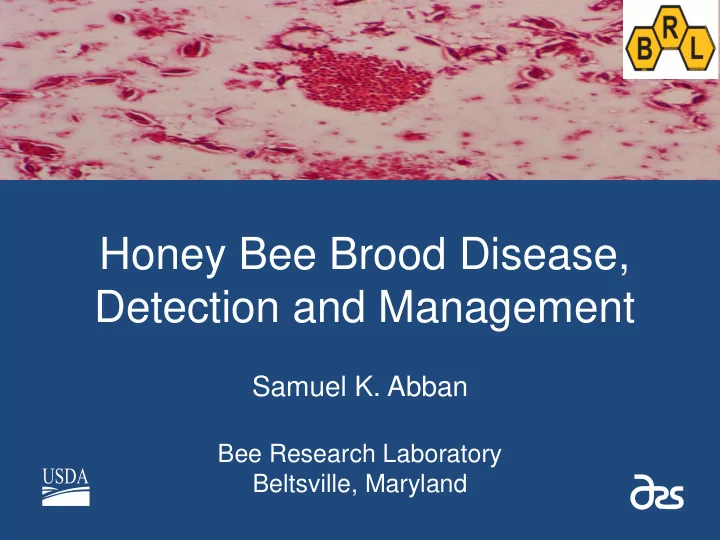

Honey Bee Brood Disease, Detection and Management Samuel K. Abban Bee Research Laboratory Beltsville, Maryland
Introduction Focus my discussion on the major brood diseases Diagnosis and treatment options Brief discussion of other pests and diseases frequently detected at the lab.
Diagnostic Service No charge for this service Receives 2,500 plus samples per year Samples sent by Beekeepers or apiary inspectors 3 – 5 days average turnaround time for sample processing
Diagnostic Service 2702 samples processed in 2016: 1001 (37%) brood samples 1,688 (62%) bee samples 13 (1%) other - pollen, honey, beetles, royal jelly, etc.
Diagnostic Service Samples from MD in 2016: 93 (3.4%) samples processed 43 (46%) were comb and smear 10 (23%) diagnosed with AFB 12 (28%) diagnosed with EFB
Brood Diseases American foulbrood European foulbrood Chalkbrood Sacbrood (virus)
Field Diagnosis of Brood Diseases
Sampling Diseased Colony smear Comb Probe or comb piece cut out around brood chamber area No honey should be present in sample Loosely wrapped sample in paper, not plastic or foil wrap
American Foulbrood Caused by Paenibacillus larvae Spore forming bacterium (2.5B/scale) Highly contagious Usually kills colony 123 (12%) samples diagnosed in 2016
American Foulbrood Brood with comb AFB
European Foulbrood Caused by Melissococcus plutonius Non spore forming bacterium Stress Disease Normally does not kill colony Associative organisms present 245 (24%) samples diagnosed in 2016
European Foulbrood Brood comb with EFB
Diagnosing Foulbrood Under the Microscope Examining a comb sample for foulbrood
Diagnosis Foulbrood Under the Microscope Transfer sample to glass cover slip.
Diagnosing Foulbrood Under the Microscope Place sample under heat lamp to dry. This fixes the sample to the cover slip.
Diagnosing Foulbrood Under the Microscope Stain sample with carbol fuchsin for 30 seconds.
Diagnosing of Foulbrood Under the Microscope Gently wash off excess stain with water.
Diagnosing Foulbrood Under the Microscope Place wet cover glass with sample side down on slide.
Diagnosing Foulbrood Under the Microscope Place slide on microscope and view at 1,000X. P. larvae spores are uniform in shape, oval and twice as long as wide. Moves with Brownian movement M. plutonius cells are lancet shape, and usually found in singles, pairs or chains. Cells clutters and fixes to slide
1000x Paenibacillus larvae – causative organism for AFB
1000x Melissococcus plutonius – Causative organism of EFB
Diagnosing Foulbrood with Test Kit ELISA Test kit available for both AFB and EFB
Foulbrood Culturing and Antibiotic Sensitivity Testing Conducted only for AFB Oxytetracycline (OTC) and Tylan AFB spore suspensions Heat shocked AFB suspensions
Foulbrood Culturing and Antibiotic Sensitivity Testing Preparing Petri Streaking Petri dish Placing antibiotic disk on dishes with AFB Petri dish
Foulbrood Culturing and Antibiotic Sensitivity Testing OTC “Susceptible” AFB OTC “Resistant” AFB “OTC Susceptible” AFB “OTC Resistant” AFB 18mm inhibition zone 52mm inhibition zone 13% resistant and 87% susceptible to OTC in 2016 No sample resistant to Tylan
American Foulbrood Spread Robbing bees Used beekeeping equipment Transfer of equipment from a diseased colony to a healthy colony
American Foulbrood Control: Burning Sterilization Drugs?
European Foulbrood Controlled by Terramycin Follow label directions Treat 3 times at 5 day intervals Do not treat hive 3 weeks before or during honey flow
Chalkbrood Ascosphaera apis Caused by a fungus No medication for treatment Requeen colony Chalkbrood
Sacbrood Morator aetalulas Caused by a virus Does not cause severe damage Common in spring Larva with SBV
Other Pests and Disease Nosema Disease A microsporidian (parasitic fungi) Infection of digestive tract of adult bees Two species: Nosema apis Nosema spores Nosema ceranae Nosema sp .
Other Pests and Disease Varroa Mites External parasitic mite Present serious threat to colony health Activates/transmits viruses V. destructor Honey bee tracheal mites Internal parasitic mite Becoming less of a problem Some of the chemical treatments for varroa kill HBTM A. woodi
BRL Bee Disease Diagnostic Service We do not conduct… Viruses testing Pesticide testing (done by USDA-AMS-National Chalkbrood mummy Science Lab) Race identification (done by USDA Tucson Lab when requested by State or Fed Government) Varroa Tropilaelaps
How to Submit Samples How to Send Brood Samples A comb sample should be at least 2 x 2 inches and contain as much of the dead or discolored brood as possible. NO HONEY SHOULD BE PRESENT IN THE SAMPLE. The comb can be sent in a paper bag or loosely wrapped in a paper towel, newspaper, etc. and sent in a heavy cardboard Bee Disease Diagnosis box. AVOID wrappings such as plastic, aluminum foil, waxed Bee Research Laboratory paper, tin, glass, etc. because they promote decomposition 10300 Baltimore Blvd and the growth of mold. Bldg. 306, Room 317 BARC – East Beltsville, MD 20705 If a comb cannot be sent, the probe used to examine a diseased larva in the cell may contain enough material for tests. The probe can be wrapped in paper and sent to the laboratory in an envelope.
Summary Foulbrood is a problem in MD Nationwide, seeing some resistant to Oxytetracycline AFB is the most destructive of all the brood diseases.
Questions?
Recommend
More recommend